The front suspension of the car is independent, with four levers, suspension struts, coil springs and anti-roll bar
The main element of the front suspension is the shock strut, which combines the functions of the telescopic element of the guide mechanism and the damping element of vertical vibrations of the wheel relative to the body
A coil spring is assembled on the shock absorber strut, the upper support with a compression buffer, through which the load is transferred to the car body
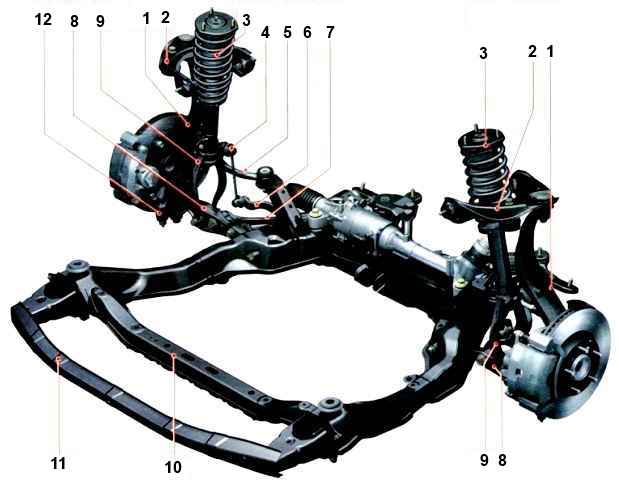
The shock strut is connected to the lower arm of the front suspension by a shock strut support
The steering knuckle is connected to the lower arm by a bracket, and to the upper arm by a ball joint
The lower arm is attached to the front suspension subframe using silent blocks, and to the stretching bolts (two on the left and right sides)
The extension of the lower arm of the front suspension is attached to the subframe of the front suspension using a silent block with two bolts.
The subframe, in turn, is attached to the body side members with bolts and nuts
The anti-roll bar with rubber bushings mounted on it is connected to the subframe with two brackets, and to the shock absorber support by stabilizer struts
The front wheel hubs are mounted on double-row angular contact ball bearings
Checking the front suspension
We install the car on a lift or a viewing ditch
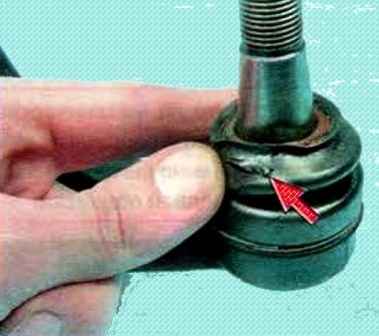
During maintenance, it is necessary to check the condition of the protective covers of ball joints
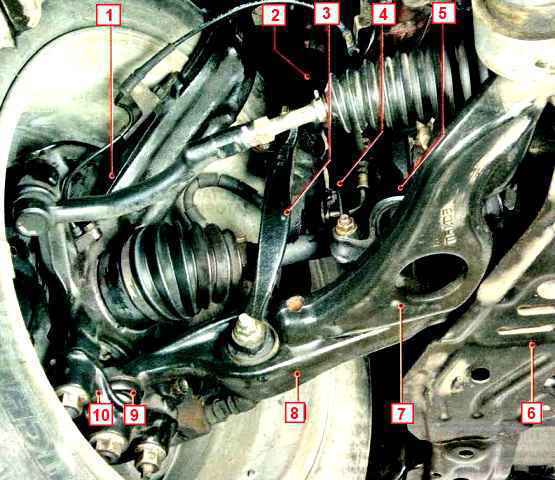
We check for cracks on the suspension parts or traces of rubbing against road obstacles or the body, deformation of the levers, stabilizer bars and their struts, parts of the front end of the body at the points of attachment of the nodes and suspension parts
Checking the condition of the rubber-metal joints, rubber pads, suspension ball joints and the condition of the upper supports of the suspension struts
Rubber-metal hinges and rubber pads must be replaced in case of ruptures and one-sided bulging of the rubber, as well as cutting their end surfaces
Suspensions on rubber parts are not allowed:
- - signs of rubber aging;
- - mechanical damage
Suspensions on rubber-metal parts are not allowed:
- - signs of aging, cracks, one-sided swelling of the rubber array;
- - separation of the rubber array from the armature
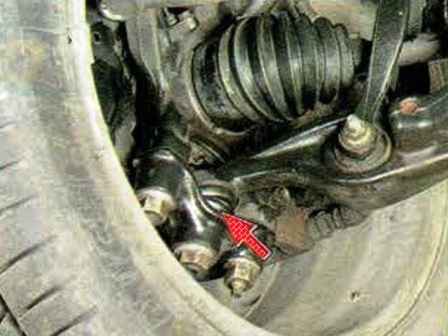
Check the condition of the protective covers of the ball bearings of the lower and upper arms.

If the covers are damaged, replace the ball bearings as an assembly
Swinging the wheel in a vertical plane, we check the ball joints for backlash.
If there are backlashes of the ball pins, we replace the bearings
When swaying the suspended front wheel, it is difficult to distinguish play in the hub bearings and ball bearings
Have an assistant press the brake pedal; if play is felt in this case, then the ball bearings are faulty

We check the absence of play in the silent blocks and rubber bushings at the attachment points of the upper, lower arms and extensions, using a mounting spatula
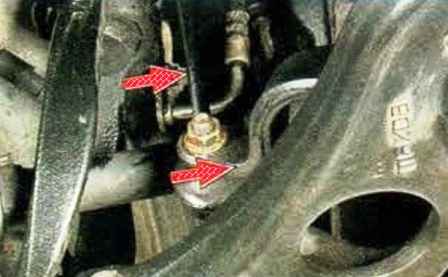
Check the condition of the struts and rubber pads of the anti-roll bar by rocking the stabilizer bar up and down
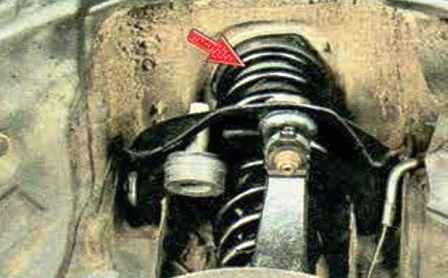
Checking the condition of the protective cover of the shock strut
Check the shock absorber for leaks. Fluid leaks are not allowed
We replace defective or damaged parts
Possible malfunctions of the front suspension and solutions
Noise and knocking when the car is moving
- weakening of the attachment to the body of the stabilizer brackets and its struts to the lower suspension arm
Tighten loose screw connections
- wear of the rubber elements of the stabilizer and its struts
Replace worn parts Replacing Mazda 6 front suspension stabilizer elements
- wear of ball joints
Replace worn hinges
- wear of the front wheel hub bearings or loosening of the hub nut
Replace bearings or tighten nut
- front suspension spring failure
Replace the spring Disassembling and assembling the shock absorber strut of a Mazda 6 car 6
- shock strut compression buffer destruction
Replace the compression buffer
- unacceptable imbalance of the front wheels
Balance the wheels
Avoiding a car from a straight line on a horizontal road
- uneven tire pressure
Set your tires to the correct pressure
- unequal spring settlement
Replace the sagging spring
- significant difference in tire tread wear
Replace a worn tire
- violation of the angles of the longitudinal inclination of the axis of rotation of the front wheels
Adjusting the angles of the longitudinal inclination of the axis of rotation of the front wheels is not provided for by the design of the car
If the angles are out of tolerance, retighten all front suspension fasteners and replace damaged or worn parts
- violation of the camber angles of the front wheels
Same as above
- uneven tire bead stiffness
Move the tire to the other side
Increased or uneven tire tread wear
- toe and wheel alignment are broken
Adjust toe and correct misalignment of wheels
- increased wear of the lower ball joints, steering rod joints and suspension silent blocks
Replace worn parts
- unacceptable wheel imbalance
Balance the wheels
- the body is deformed or the suspension parts are damaged
Repair the bodywork and replace damaged parts
- suspension strut operation is broken
Replace the shock strut





